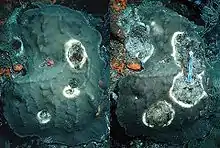
Yellow-band disease (similar to Yellow Blotch disease)[1] is a coral disease that attacks colonies of coral at a time when coral is already under stress from pollution, overfishing, and climate change.[2] It is characterized by large blotches or patches of bleached, yellowed tissue on Caribbean scleractinian corals.[3]
Yellow-band disease is a bacterial infection that spreads over coral, causing the discolored bands of pale-yellow or white lesions along the surface of an infected coral colony. The lesions are the locations where the bacteria have killed the coral's symbiotic photosynthetic algae, called zooxanthellae which are a major energy source for the coral.[4] This cellular damage and the loss of its major energy source cause the coral to starve, and usually cause coral death. There is evidence that climate change could be worsening the disease.[5]
Mechanism of action
Coral has a symbiotic relationship with zooxanthellae that provide the coral glucose, glycerol, and amino acids. Under certain water conditions, like fluctuating temperatures and increased nitrogenous waste, corals will appear stressed. Also, these conditions allow for bacteria to grow inside the coral and compete with zooxanthellae. The bacteria produces the characteristic pale yellow lesions and eventually kills the zooxanthellae by impairing its mitosis and its ability to carry out photosynthesis. Yellow-band disease is found on coral reefs in the Caribbean.[6]
Impact
Yellow-band disease has severely affected reef building corals in the Caribbean. This disease have been associated with lower coral fecundity,[7] altered tissue composition[8] and a lower activities of antixenobiotic and antioxidant enzymes.[9] Compared to the late 1990s, current data suggests that the disease remains a severe epidemic. In one study, 10 meter belt transects were taken at various depths, sampling coral colonies in the Lesser Antilles. At a depth of 5 m, yellow band rings and lesions were found on 79% of the colonies per transect, and only 21% of the colonies in this depth range appeared healthy.[10]
Recent research indicates that yellow-band disease continues to be in an infectious phases in the Caribbean. It has been found to cause infection in Pacific coral as well.[10]
See also
- Aspergillosis, caused by the fungus Aspergillus sydowii, affects Gorgonian soft corals commonly known as sea fans.
- Black band disease, caused by a microbial consortium dominated by the cyanobacteria Phormidium corallyticum.
- Black necrosing syndrome, or Dark spots disease, probably fungal.
- Brown band disease, or Red band disease, probably caused by protozoa (possibly Helicostoma nonatum) and cyanobacteria.
- Rapid wasting, possibly caused by a fungus growing on areas damaged by the feeding of parrotfish Sparisoma viride.
- White band disease, the cause of this disease remains unknown.
- White plague, caused by the bacterium Aurantimonas coralicida.
- Skeletal eroding band, caused by the protozoan Halofolliculina corallasia.
Notes
- ↑ Yellow-blotch/Yellow-band Disease
- ↑ "yellow band disease News - insciences". insciences.org. Retrieved 2009-10-28.
- ↑ "Common Identified Coral Diseases". www.artificialreefs.org. Retrieved 2009-10-28.
- ↑ "NOAA National Ocean Service Education: Example of yellow band disease". oceanservice.noaa.gov. Retrieved 2009-10-28.
- ↑ "Yellow band disease is spreading". X-Ray International Dive Magazine. www.xray-mag.com. Retrieved 2009-10-28.
- ↑ Holzman, David. "Vibrio Consortia, Warming Seas Aggravate Yellow Band Disease in Corals". www.microbemagazine.org. Retrieved 2009-10-28.
- ↑ Weil, E; Cróquer, A; Urreiztieta, I (16 November 2009). "Yellow band disease compromises the reproductive output of the Caribbean reef-building coral Montastraea faveolata (Anthozoa, Scleractinia)". Diseases of Aquatic Organisms. 87 (1–2): 45–55. doi:10.3354/dao02103. PMID 20095240.
- ↑ Guerra, M; López, Ma; Estéves, I; Zubillaga, Al; Cróquer, A (16 January 2014). "Fourier-transformed infrared spectroscopy: a tool to identify gross chemical changes from healthy to yellow band disease tissues". Diseases of Aquatic Organisms. 107 (3): 249–258. doi:10.3354/dao02680. PMID 24429476.
- ↑ Montilla, Lm; Ramos, R; García, E; Cróquer, A (3 May 2016). "Caribbean yellow band disease compromises the activity of catalase and glutathione S-transferase in the reef-building coral Orbicella faveolata exposed to anthracene". Diseases of Aquatic Organisms. 119 (2): 153–161. doi:10.3354/dao02980. PMID 27137073.
- 1 2 Donà, A. Richards; Cervino, J.M.; Goreau, T.J.; Bartels, E.; Hughen, K.; Smith, G.W.; Donà, A. (July 2008). Coral Yellow Band Disease; Current Status in The Caribbean, Outbreaks And The Links To New Indo-Pacific Lesions (PDF). Proceedings of the 11th International Coral Reef Symposium. Ft. Lauderdale, Florida.
External links
- Bruckner, Andrew W; Bruckner, Robin J (23 March 2006). "Consequences of yellow band disease (YBD) on Montastraea annularis (species complex) populations on remote reefs off Mona Island, Puerto Rico". Diseases of Aquatic Organisms. 69 (1): 67–73. doi:10.3354/dao069067. PMID 16703767. INIST 17774279.
- Priorities for Effective Management of Coral Diseases
- Cervino, J.M.; Thompson, F.L.; Gomez-Gil, B.; Lorence, E.A.; Goreau, T.J.; Hayes, R.L.; Winiarski-Cervino, K.B.; Smith, G.W.; Hughen, K.; Bartels, E. (November 2008). "The Vibrio core group induces yellow band disease in Caribbean and Indo-Pacific reef-building corals". Journal of Applied Microbiology. 105 (5): 1658–1671. doi:10.1111/j.1365-2672.2008.03871.x. PMID 18798767.